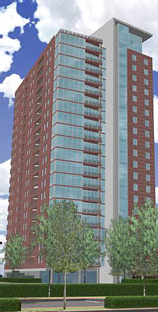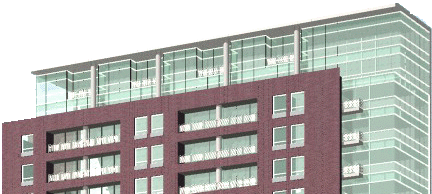Building Statistics
 General Building Data
General Building Data
Building Name: Christina Landing Apartment Tower
Location and Site: Wilmington, DE. On the south side of the Christina River bordered by Market Street, A Street, and Walnut Street.
Building Occupant Name: Private Residences (Rented by Patterson-Schwartz Real Estate)
Occupancy of Function Types: Apartment Building
Size: 248,884 sqft
Number of Stories Above Grade: 22 Stories
Primary Project Team:
Owner: Buccini Pollin Group
Website: http://www.bpgroup.net/
Architect and All Engineering Disciplines: Kling
Website: http://www.kling.us
General Contractor: Gilbane Building Co.
Website: http://www.gilbanco.com
Dates of Construction:
Start: April 2004
Finish: October 2005
Cost: Approximately 60 million (trying to get a better answer)
Project Deliver Method: Design-Bid-Build
Architecture
The 23 story Christina Landing Apartment Tower will be one of the tallest buildings in Wilmington, and will have a significant impact on the city. The tower is part of a residential construction project on the south side of the Christina River which includes 63 townhouses, a river walk, and a two acre park. The tower itself consists of 173 one and two bedroom apartments with balconies, a media room, a fitness center, a great room, a bar, a convenience store, a dry cleaners, and on site parking. Floors 3-20 are typical of the building, each containing 6 single apartments and 3 double apartments. The first and second floors house the retail and common spaces, and the 21st and 22nd floors consist of two story penthouses.
Being a highly visible new housing project in Wilmington, the architects had to be mindful of the design they chose. The building materials; brick, glass, and metal cladding give a consistent feel with the older factories in the vicinity. However, the tower does not seem dated but has a simple modern look.
Codes, Regulations and Standards
Building Officials and Code Administrators (BOCA) National Building Code / 1996 with City of Wilmington Amendments.
National Fire Protection Association, NFPA 101, Life Safety Code (LSC) / 2000
Delaware State Fire Prevention Regulations including LSC, 2000 (NFPA 101)
Council of American Building Officials/American National Standards Institute (CABO/ANSI)
Accessible and Usable Buildings and Facilities / A117.1-1992
ANSI/ASME Standard A17.1 Safety Code for Elevators and Escalators
ICC International Mechanical Code/1996
ICC International Plumbing Code/1995
The National Electrical Code (NFPA 70)/1996
Zoning and Historical
The site was used as a planning mill, coal and lumberyard during the late nineteen hundreds. By the 1920s the site was used for an aboveground storage tank farm for the American Oil Company. It was used for this function until 1980 when the site was operated as the Christina River Club restaurant. These historical conditions only slightly affected the construction process in the form of existing foreign objects in the soil.
The fact that construction of the tower is taking place so closely to the Christina River made it necessary to follow certain environmental regulations to protect the waterway and the construction workers. (more info to come in construction section)
Building Envelope
The building envelope consists of two main wall systems and a roof system. The primary wall system which covers most of each of the two long faces of the tower is a non-structural precast concrete panel with a thin architectural brick veneer. The panels are backed by a semi-rigid insulation and are hung from the building structure. The other sides of the building are comprised of an aluminum framed glass curtain wall system. The roofing system is a structural concrete slab topped with rigid insulation, coverboard, and a 2-ply roofing membrane. The building envelope also uses aluminum framed windows and sliding glass doors, metal panel wall assemblies, and louver assemblies.
Construction
The construction project was managed by Gilbane Co.. There were several notable construction issues for the project. Because the site is located directly on the Christina River the tower level was raised 5 feet above the flood plane before construction began. It was also necessary to drive H-piles up to 70ft deep for the building’s foundation system. The floors were cast using a flying form system which allowed for quicker turnover time between floors due to forming time savings. Construction started August 2004, the building topped out in May 2005, and substantial completion was during November 2005.
Electrical
After a metering issue with the local power company, Connective Utilities, it was decided that two separate feeds would enter into the building. The lines feed into two separate pad mounted transformers. One transformer is for 208/120V power and one is for 480/277V. After passing through a 400A service entrance rated breaker the 208/120V line is used in a 4000A, 3 phase, 4 wire plug-in busway, which travels the height of the building. Every other story has a metering switchboard pluged into the busway with 18 meters, one for each of the apartments on the two floors serviced by the switchgear. This metering switchboard branches off to150A panels in each apartment unit. The 480/277V line serves a variety of equipment in the building; the air handling units, some lighting, the elevator motors, the fire pump, and the domestic water pumps. The tower also has a 500kW/625kVA generator whose main purpose is to serve the emergency fire pump, but also serves the domestic water pumps, and the emergency lighting.
Structural:
The building’s structural support systems are primarily cast-in-place concrete. Starting at the roof, the primary support is a reinforced 8” concrete slab, however there are some beams in the area of the elevator machine room. All floors are supported by a reinforced 8” structural slab with #6 bars at 10” O.C. each way in the top and #4 bars at 10” O.C. each way in the bottom. The building has both round and square columns. They range in size from 16x16 to 24x24 for square columns and from 24” dia. To 32” dia. for round columns. The main wind force resisting system is a core box of 4, 12” thick shear walls traveling the height of the structure. The columns and shear walls sit on grade beams which transfer the building loads into the pile caps which range in size from 5’x8’x43” over 2 piles to 10’x11’x60” over 8 piles. Supporting the piles caps are H12x74 piles of various lengths. There is some structural steel in the building but it only comprises a small portion of the structure.
Mechanical
Due to the fact that the majority of the structure is comprised of apartment units its primary heating and cooling system is unlike buildings of a similar size. Each apartment utilizes one, two, or three, air to air heat pumps. A reversing valve allows these units to function as both air conditioning as well as heating units. The units are able to extract heat from the outdoor air down to a temperature of approximately 45 degrees. Below this temperature an electric resistance heater will operate. The common areas on the first and second floor are conditioned by an air to water heat pump. In this system heat is added to or extracted from a 40% ethylene glycol mix and circulated throughout. This system is effective at temperatures between approximately 50 and 90 degrees. Outside this range electric heat or fans are used to assist the process. One advantage to this system is it allows for a single process even if different locations in the building have highly varying temperatures. The heat will simply be absorbed from the warmer of the two areas and expelled in the cooler sections.
Lighting
The lighting in the apartment units is run off 208/120V power while the lighting in the common areas is 480/277V power. The building lighting is primarily fluorescent with both 6” can lights and 2’x4’ fixtures. (I do not have the lighting spec. and therefore do not know specific lighting values. I’m trying to get more info in this area.)
Fire Protection
Due to the nature of apartment buildings the risk of human life is very high. It is possible that resident could be sleeping during a fire and it is imperative that the fire protection system gives the occupants every chance of survival. Each apartment has smoke detector and the corridors have illuminated means of egress. The building is also entirely sprinkled for fire protection. The system is a wet pipe system and is powered by a pump which is run off the generator for emergencies. As soon as the temperature of a sprinkler head reaches160 degrees the sprinkler will trip and water will flow until the water pressure drops below a certain point at which time the emergency generator will activate. There is also a smaller pump which runs if a slight drop in pressure is measured possibly from a small leak. The generator also gives power to emergency lighting and 1 elevator for means of egress.
One unique fire protection system used in the structure was an advanced smoke clearing system. The system allows for the floor the fire ignited on to become negatively pressured to evacuate smoke, while the floors above and below as well as the stairwells are positively pressured to prevent smoke from entering these areas. This system is controlled by a single rooftop unit, also powered by the emergency generator.
Plumbing
There are two primary plumbing systems of the building. One line is for the incoming water and one for the exiting storm and sanitary lines. Coming into the building are two separate domestic cold water and fire protection lines. The fire protection lines will be discussed in the fire protection section. The pump employed for the domestic cold water is a triplex booster pump which consists of two larger pumps and one smaller pump. The building is separated into two zones to allow for a specific range 25-80psi exiting water pressures at both the lower and upper floors. The cold water travels into each apartment, and each have an individual electric water heater.
The building has collection areas on the 22nd and 20th floor roofs for rain water which is channeled to the bottom of the building and piped out below the first floor. The water goes into public storm sewers and eventually makes its way into the Christina River. The building also has many sanitary risers for waste water. This water is pumped out of the building into sanitary storm sewers to the local municipal water treatment plant. Features to note in the sanitary storm system are the venting requirement on the lines to allow for proper waste flow, as well as p-traps to deal with the sewer gasses.
Telecommunications
Each apartment is outfitted with cable and telephone capabilities.
Transportation
The main transportation systems in the building are 2 passenger elevators and 1 larger freight elevator.
Special Systems
Smoke ventilation system. (see fire protection systems)
